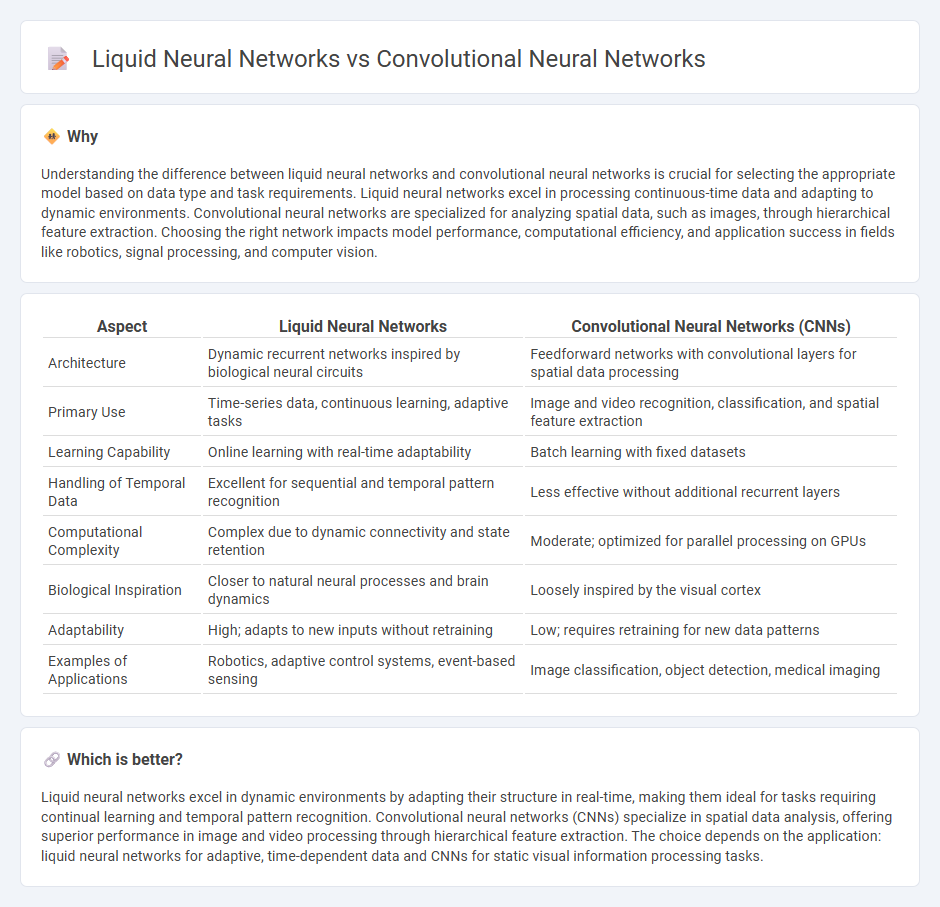
Liquid neural networks adapt dynamically to changing inputs using continuous-time signals, making them highly efficient for real-time data processing and temporal tasks. In contrast, convolutional neural networks excel at spatial feature extraction from grid-like data, such as images, through layer-wise convolution operations. Explore the distinctive capabilities and applications of these neural network architectures to deepen your understanding.
Why it is important
Understanding the difference between liquid neural networks and convolutional neural networks is crucial for selecting the appropriate model based on data type and task requirements. Liquid neural networks excel in processing continuous-time data and adapting to dynamic environments. Convolutional neural networks are specialized for analyzing spatial data, such as images, through hierarchical feature extraction. Choosing the right network impacts model performance, computational efficiency, and application success in fields like robotics, signal processing, and computer vision.
Comparison Table
| Aspect | Liquid Neural Networks | Convolutional Neural Networks (CNNs) |
|---|---|---|
| Architecture | Dynamic recurrent networks inspired by biological neural circuits | Feedforward networks with convolutional layers for spatial data processing |
| Primary Use | Time-series data, continuous learning, adaptive tasks | Image and video recognition, classification, and spatial feature extraction |
| Learning Capability | Online learning with real-time adaptability | Batch learning with fixed datasets |
| Handling of Temporal Data | Excellent for sequential and temporal pattern recognition | Less effective without additional recurrent layers |
| Computational Complexity | Complex due to dynamic connectivity and state retention | Moderate; optimized for parallel processing on GPUs |
| Biological Inspiration | Closer to natural neural processes and brain dynamics | Loosely inspired by the visual cortex |
| Adaptability | High; adapts to new inputs without retraining | Low; requires retraining for new data patterns |
| Examples of Applications | Robotics, adaptive control systems, event-based sensing | Image classification, object detection, medical imaging |
Which is better?
Liquid neural networks excel in dynamic environments by adapting their structure in real-time, making them ideal for tasks requiring continual learning and temporal pattern recognition. Convolutional neural networks (CNNs) specialize in spatial data analysis, offering superior performance in image and video processing through hierarchical feature extraction. The choice depends on the application: liquid neural networks for adaptive, time-dependent data and CNNs for static visual information processing tasks.
Connection
Liquid neural networks and convolutional neural networks (CNNs) are connected through their shared goal of improving adaptability and pattern recognition in artificial intelligence. Liquid neural networks leverage continuous-time dynamics for real-time learning and adaptability, while CNNs excel at spatial data processing and image recognition through hierarchical feature extraction. Combining these architectures enables enhanced performance in tasks requiring both temporal flexibility and spatial analysis, such as video processing and autonomous systems.
Key Terms
Feature Extraction
Convolutional Neural Networks (CNNs) excel at feature extraction through hierarchical layers that capture spatial hierarchies in image data, effectively recognizing patterns such as edges, textures, and objects. Liquid Neural Networks, inspired by biological neurons, utilize dynamic, continuous-time state updates that adapt to changing input streams, offering greater flexibility in processing temporal and sequential data. Explore more about how these architectures leverage distinct mechanisms for feature extraction and their applications in various AI domains.
Spatiotemporal Dynamics
Convolutional Neural Networks (CNNs) excel at capturing spatial hierarchies in images through fixed-weight filters but struggle with temporal dynamics, whereas Liquid Neural Networks adapt their internal states in real-time, effectively modeling complex spatiotemporal patterns. Liquid Neural Networks utilize continuous-time recurrent dynamics, making them well-suited for tasks involving evolving spatial and temporal data such as video analysis and sensor fusion. Explore in-depth comparisons and applications to understand how these distinct architectures address spatiotemporal challenges.
Adaptivity
Convolutional neural networks (CNNs) excel at spatial feature extraction through fixed-weight filters but lack real-time adaptivity to dynamic data. Liquid neural networks leverage continuous-time dynamics and adaptive state equations, enabling rapid learning and adjustment in non-stationary environments. Explore deeper into these architectures to understand their implications for adaptive intelligence.
Source and External Links
What are Convolutional Neural Networks? - IBM - Convolutional neural networks (CNNs) are a specialized type of deep learning algorithm primarily used for image classification and object recognition by automatically extracting features from three-dimensional data, such as images.
An Introduction to Convolutional Neural Networks (CNNs) - DataCamp - CNNs are distinguished by their ability to autonomously learn and detect patterns in data, making them highly effective for tasks like image classification, object detection, and segmentation without the need for manual feature engineering.
Convolutional neural network - Wikipedia - CNNs are feedforward neural networks that use convolutional layers with shared-weight filters to efficiently learn spatial hierarchies of features from input data, widely applied in image and video recognition, medical analysis, and beyond.
 dowidth.com
dowidth.com